Morphine induces desensitization of insulin receptor signaling
- PMID: 12917346
- PMCID: PMC180943
- DOI: 10.1128/MCB.23.17.6255-6266.2003
Morphine induces desensitization of insulin receptor signaling
Abstract
Morphine analgesia is mediated principally by the micro -opioid receptor (MOR). Since morphine and other opiates have been shown to influence glucose homeostasis, we investigated the hypothesis of direct cross talk between the MOR and the insulin receptor (IR) signaling cascades. We show that prolonged morphine exposure of cell lines expressing endogenous or transfected MOR, IR, and the insulin substrate 1 (IRS-1) protein specifically desensitizes IR signaling to Akt and ERK cascades. Morphine caused serine phosphorylation of the IR and impaired the formation of the signaling complex among the IR, Shc, and Grb2. Morphine also resulted in IRS-1 phosphorylation at serine 612 and reduced tyrosine phosphorylation at the YMXM p85-binding motifs, weakening the association of the IRS-1/p85 phosphatidylinositol 3-kinase complex. However, the IRS-1/Grb2 complex was unaffected by chronic morphine treatment. These results suggest that morphine attenuates IR signaling to Akt by disrupting the IRS-1-p85 interaction but inhibits signaling to ERK by disruption of the complex among the IR, Shc, and Grb2. Finally, we show that systemic morphine induced IRS-1 phosphorylation at Ser612 in the hypothalamus and hippocampus of wild type, but not MOR knockout, mice. Our results demonstrate that opiates can inhibit insulin signaling through direct cross talk between the downstream signaling pathways of the MOR and the IR.
Figures


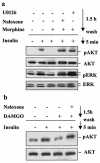
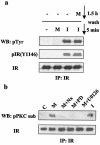
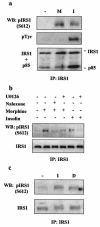
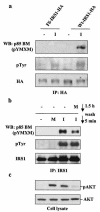

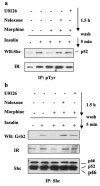

Similar articles
-
Different pathways of postreceptor desensitization following chronic insulin treatment and in cells overexpressing constitutively active insulin receptors.J Biol Chem. 1996 Nov 8;271(45):28206-11. doi: 10.1074/jbc.271.45.28206. J Biol Chem. 1996. PMID: 8910437
-
Src-family tyrosine kinases in activation of ERK-1 and p85/p110-phosphatidylinositol 3-kinase by G/CCKB receptors.J Biol Chem. 1999 Jul 16;274(29):20657-63. doi: 10.1074/jbc.274.29.20657. J Biol Chem. 1999. PMID: 10400698
-
Effects of streptozocin diabetes and diabetes treatment by islet transplantation on in vivo insulin signaling in rat heart.Diabetes. 2001 Dec;50(12):2709-20. doi: 10.2337/diabetes.50.12.2709. Diabetes. 2001. PMID: 11723053
-
Insulin signalling.J Cell Sci. 2001 Apr;114(Pt 8):1429-30. doi: 10.1242/jcs.114.8.1429. J Cell Sci. 2001. PMID: 11282018 Review. No abstract available.
-
Current Studies on Molecular Mechanisms of Insulin Resistance.J Diabetes Res. 2022 Dec 23;2022:1863429. doi: 10.1155/2022/1863429. eCollection 2022. J Diabetes Res. 2022. PMID: 36589630 Free PMC article. Review.
Cited by
-
Direct binding of p85 to sst2 somatostatin receptor reveals a novel mechanism for inhibiting PI3K pathway.EMBO J. 2006 Sep 6;25(17):3943-54. doi: 10.1038/sj.emboj.7601279. Epub 2006 Aug 17. EMBO J. 2006. PMID: 16917505 Free PMC article.
-
Insulin Sensitivity Is Associated with Lipoprotein Lipase (LPL) and Catenin Delta 2 (CTNND2) DNA Methylation in Peripheral White Blood Cells in Non-Diabetic Young Women.Int J Mol Sci. 2019 Jun 15;20(12):2928. doi: 10.3390/ijms20122928. Int J Mol Sci. 2019. PMID: 31208038 Free PMC article.
-
Profiling neuronal methylome and hydroxymethylome of opioid use disorder in the human orbitofrontal cortex.Nat Commun. 2023 Jul 28;14(1):4544. doi: 10.1038/s41467-023-40285-y. Nat Commun. 2023. PMID: 37507366 Free PMC article.
-
Metabolic and Addiction Indices in Patients on Opioid Agonist Medication-Assisted Treatment: A Comparison of Buprenorphine and Methadone.Sci Rep. 2020 Mar 27;10(1):5617. doi: 10.1038/s41598-020-62556-0. Sci Rep. 2020. PMID: 32221389 Free PMC article.
-
Interleukin-1 beta impairs brain derived neurotrophic factor-induced signal transduction.Neurobiol Aging. 2008 Sep;29(9):1380-93. doi: 10.1016/j.neurobiolaging.2007.02.027. Epub 2007 Apr 27. Neurobiol Aging. 2008. PMID: 17467122 Free PMC article.
References
-
- Aguirre, V., T. Uchida, L. Yenush, R. Davis, and M. F. White. 2000. The c-Jun NH2-terminal kinase promotes insulin resistance during association with insulin receptor substrate-1 and phosphorylation of Ser307. J. Biol. Chem. 275:9047-9054. - PubMed
-
- Aguirre, V., E. D. Werner, J. Giraud, Y. H. Lee, S. E. Shoelson, and M. F. White. 2002. Phosphorylation of Ser307 in insulin receptor substrate-1 blocks interactions with the insulin receptor and inhibits insulin action. J. Biol. Chem. 277:1531-1537. - PubMed
-
- Baumhaker, Y., M. Gafni, O. Keren, and Y. Sarne. 1993. Selective and interactive down-regulation of μ- and δ-opioid receptors in human neuroblastoma SK-N-SH cells. Mol. Pharmacol. 44:461-467. - PubMed
-
- Belcheva, M. M., M. Szucs, D. Wang, W. Sadee, and C. J. Coscia. 2001. μ-Opioid receptor-mediated ERK activation involves calmodulin-dependent epidermal growth factor receptor transactivation. J. Biol. Chem. 276:33847-33853. - PubMed
MeSH terms
Substances
Grants and funding
LinkOut - more resources
Full Text Sources
Molecular Biology Databases
Research Materials
Miscellaneous
